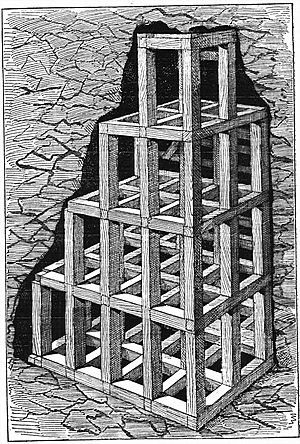Carson and Tahoe Lumber and Fluming Company facts for kids
The Carson and Tahoe Lumber and Fluming Company (C&TL&F) was a very important company that moved wood from the forests around Lake Tahoe. This wood was needed for the silver mines in a famous area called the Comstock Lode. From 1872 to 1898, C&TL&F moved a massive amount of wood – enough to cover 80,000 football fields! This wood was used to build and support the busy mines.
Contents
How the Company Started
In 1860, a man named Augustus Pray moved to Glenbrook, Nevada, right by Lake Tahoe. He set up a sawmill to cut down trees into useful wood. He even built a paddle wheel tugboat called Governor Blasdel to pull rafts of logs across the lake to his sawmill.
There was a huge need for wood on the other side of the mountains, where the silver mines were. Miners needed homes, and the mines themselves needed a lot of wood to keep their tunnels from collapsing. This special way of supporting the mines was called square set timbering. Other tugboats like the Truckee and Emerald also started bringing logs to Glenbrook.
In 1872, Duane Leroy Bliss created the C&TL&F company. His plan was clever: he would build a special narrow-gauge railway from the sawmill up to Spooner Summit. From there, he bought a water system with a long wooden flume. This flume was like a giant waterslide for wood, floating it 12 miles down to the main Virginia and Truckee Railroad in Carson City, Nevada.
The Lake Tahoe Railroad
| Overview | |
|---|---|
| Headquarters | Glenbrook, Nevada |
| Locale | Douglas County, Nevada |
| Dates of operation | 1875–1898 |
| Successor | abandoned |
| Technical | |
| Track gauge | 3 ft (914 mm) |
| Length | 8.75 mi (14.08 km) |
The company first bought a V-shaped flume in 1869. At first, wagons carried the wood uphill. But in 1875, the 8.75-mile-long Lake Tahoe Railroad was built. This railroad helped move wood from two new sawmills that C&TL&F built in Glenbrook.
The railway climbed 910 feet up the hill. It even had two switchbacks to help the trains get up the steep slopes. The Baldwin Locomotive Works built two special steam engines for the railroad, named Tahoe and Glenbrook. Each engine could pull six flatcars loaded with wood to the top. Sometimes, they used two engines to pull twelve cars!
By 1877, the railroad had 75 flatcars. A third engine was built that year to keep up with the demand for wood. To make sure everything ran smoothly, one of the first telephone systems in the west was set up between Glenbrook and Carson City. As more logs were needed, C&TL&F bought two more tugboats, the Meteor in 1876 and the Emerald (II) in 1887. When one of their sawmills burned down in 1887, the other sawmill had to work 24 hours a day to keep producing wood.
The Lake Valley Railroad
| Overview | |
|---|---|
| Headquarters | Glenbrook, Nevada |
| Locale | El Dorado County, California |
| Dates of operation | 1884–1898 |
| Successor | abandoned |
| Technical | |
| Track gauge | 3 ft (914 mm) |
| Length | 11 mi (18 km) |
In 1886, C&TL&F bought another railway called the Lake Valley Railroad from George Chubbuck. This line ran south from Bijou, California to Meyers, California. It brought logs down to Lake Tahoe, where C&TL&F steamboats would then tow them to the sawmills in Glenbrook.
The Lake Valley Railroad first used wooden rails, which a simple locomotive quickly broke. So, Chubbuck put down stronger metal rails and bought a new locomotive. After C&TL&F bought the line, they sent one of their Lake Tahoe Railroad engines to help. Both of these locomotives were later sold to another railroad when the Lake Valley Railroad was taken apart in 1898.
From Lumber to Tourism
Over time, the silver in the Comstock Lode mines started to run out. This meant less wood was needed. So, Duane Bliss, the founder of C&TL&F, started focusing on something new: tourism!
In 1895, Bliss created the Lake Tahoe Railway and Transportation Company. He launched a large 200-passenger steamboat called the Tahoe in 1896. He also bought another passenger steamer named Nevada.
By 1898, the C&TL&F company stopped floating wood down the flume. The Lake Tahoe Railroad was taken apart. But its story didn't end there! In 1899, the railroad was put back together on the other side of Lake Tahoe. It became a 16-mile-long tourist railway, connecting Tahoe City to the Southern Pacific Railroad at Truckee, California. This new railway helped bring visitors to Bliss's new resort at Tahoe City.




